Please note: As an Amazon Associate I earn from qualifying purchases. I also work with other affiliate partners and may be compensated from the links below. Details here.
Photography Terms List: 25 Photography Words for Beginners to Learn About

We’ve all been there.
The challenge of not knowing basic photography words and what they mean.
That’s why I’ve created this photography terms list for beginners.
Now…
While it’s challenging to provide an exhaustive list in one post, I can offer you a comprehensive glossary of essential terms in digital photography.
First, let’s start with a quick summary list.
25 Photography Words List (Summary)
- Aperture: The opening in a lens through which light passes to enter the camera body. Measured in f-stops.
- Shutter Speed: The duration for which the camera’s shutter remains open, controlling the amount of light that reaches the camera sensor.
- ISO: A measure of the sensitivity of the camera’s sensor to light. Higher ISO values are used in low-light conditions but may introduce more noise.
- Exposure: The amount of light that reaches the camera sensor, determined by the combination of aperture, shutter speed, and ISO.
- White Balance: Adjustment of colors in an image to make it appear more natural under different lighting conditions.
- RAW: A file format that contains minimally processed data from the camera sensor, allowing for more extensive post-processing.
- JPEG: A compressed image file format commonly used in digital photography.
- Histogram: A graphical representation of the distribution of tones in an image, helping to evaluate exposure.
- Depth of Field: The range of distances within an image that appears acceptably sharp. Controlled by the aperture.
- Bokeh: The aesthetic quality of the out-of-focus areas in an image, often achieved with a shallow depth of field.
- Bracketing: Capturing a series of images with varying exposure settings to ensure at least one is correctly exposed.
- Focal Length: The distance between the lens and the image sensor, influencing the perspective and magnification of the image.
- Autofocus: A camera feature that automatically adjusts the focus of the lens to ensure sharp images.
- Manual Mode: A shooting mode where the photographer has full control over settings like aperture, shutter speed, and ISO.
- Exif Data: Metadata embedded in an image file that contains information about the camera settings, date, and time of capture.
- Rule of Thirds: A compositional guideline dividing the frame into thirds both horizontally and vertically, helping to create balanced and interesting compositions.
- Crop Factor: The ratio of the dimensions of a camera’s imaging sensor to a full-frame sensor, affecting the effective focal length of lenses.
- Dynamic Range: The range of light intensities from the darkest shadows to the brightest highlights that a camera can capture.
- Chromatic Aberration: An optical distortion causing color fringing, often seen at high-contrast edges in an image.
- Image Stabilization: A technology that reduces the effects of camera shake, typically found in lenses or camera bodies.
- Hyperfocal Distance: The closest focusing point that maintains acceptable sharpness from half that distance to infinity, crucial for achieving maximum depth of field in landscape photography.
- Resolution: the level of detail and clarity in an image, determined by the number of pixels in the photograph, with higher resolution resulting in sharper and more detailed pictures.
- ND Filter: a lens accessory that reduces incoming light without altering color, enabling photographers to achieve creative effects like motion blur or wider apertures in bright conditions.
- Vignetting: A gradual darkening or reduction in brightness at the edges of an image, often unintentional, caused by various factors such as lens limitations or improper camera settings.
- Panning: A technique where the camera moves with a moving subject, creating a sense of motion while keeping the subject sharp.
This list covers a broad range of terms, but if you’re interested in an extensive definition, the keep on reading.
Photography Words (More Extensive Definitions)
1. Aperture
Aperture refers to the opening within a camera lens through which light passes to enter the camera body and reach the image sensor.
It is measured in f-stops, with lower f-stop values indicating larger apertures, allowing more light, and higher f-stop values indicating smaller apertures, letting in less light.
Aperture is a crucial component in controlling the exposure and depth of field in an image.
Why does it matter for photographers?
Understanding aperture is fundamental for photographers as it directly impacts the amount of light reaching the camera sensor and influences the depth of field in an image.
A wider aperture (lower f-stop) is useful in low-light conditions or when a photographer desires a shallow depth of field to isolate a subject from the background.
Conversely, a smaller aperture (higher f-stop) is beneficial for maximizing the depth of field, ensuring more elements in the scene are in focus.
2. Shutter Speed
Shutter speed refers to the amount of time the camera’s shutter remains open, determining the duration of exposure to light. It is measured in seconds or fractions of a second.
Faster shutter speeds result in less light reaching the sensor and are suitable for freezing fast-moving subjects, while slower shutter speeds allow more light and can create a sense of motion.
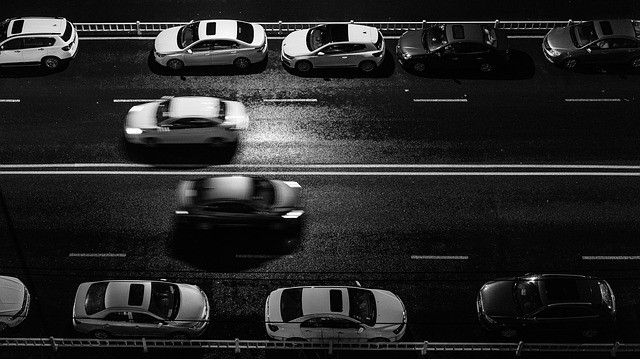
Why does it matter for photographers?
Shutter speed is critical for capturing moving subjects or controlling the perception of motion in an image.
Knowing how to adjust shutter speed enables photographers to freeze action, capture dynamic motion blur, or work in low-light situations.
Mastery of shutter speed contributes to the overall technical competence of a photographer and the visual impact of their images.
3. ISO
ISO, or International Organization for Standardization, in the context of digital photography, refers to the sensitivity of the camera sensor to light.
A higher ISO value increases sensor sensitivity but may introduce more digital noise or grain in the image. Lower ISO values are suitable for well-lit conditions, while higher values are employed in low-light situations.
Why does it matter for photographers?
Understanding ISO is crucial for managing exposure in various lighting conditions.
A photographer must choose an appropriate ISO setting based on the available light and desired image quality.
Balancing ISO with aperture and shutter speed is key to achieving well-exposed images without sacrificing image quality.
4. Exposure
Exposure in photography is the cumulative result of the amount of light that reaches the camera sensor. It is determined by the combination of aperture, shutter speed, and ISO settings.
Proper exposure ensures that an image has the right balance of light and dark areas, revealing details and creating a visually appealing photograph.
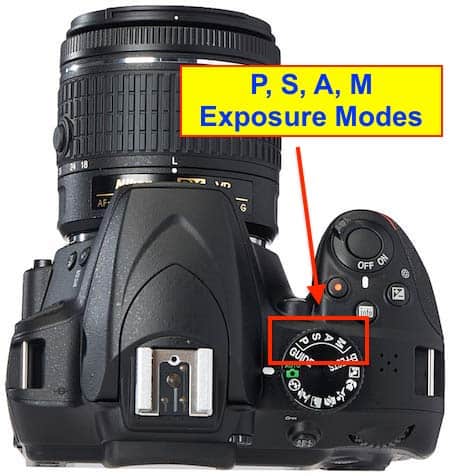
Why does it matter for photographers?
Mastering exposure is fundamental to producing high-quality images.
Understanding how aperture, shutter speed, and ISO work together allows photographers to achieve the desired level of brightness and contrast in their photos.
This knowledge is essential for creating well-exposed images in various lighting conditions.
5. White Balance
White balance is the adjustment of colors in an image to ensure that whites appear neutral and colors are true to life, regardless of the lighting conditions under which the photo was taken.
It is a critical aspect of color correction in digital photography.
Why does it matter for photographers?
White balance is essential for producing accurate and visually pleasing colors in photographs. Incorrect white balance can lead to images with a color cast, where the overall tone appears too warm or too cool.
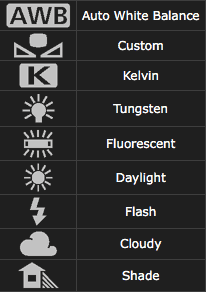
Understanding how to set the white balance appropriately ensures that the colors in a photograph are faithful to the scene and the photographer’s vision.
6. RAW
RAW is an uncompressed and minimally processed file format that contains all the data captured by the camera sensor.
Unlike JPEG, which applies in-camera processing and compression, RAW files provide greater flexibility for post-processing adjustments.
Why does it matter for photographers?
Shooting in RAW format offers photographers more control over the final appearance of their images during post-processing.
RAW files retain a higher level of detail and allow adjustments to exposure, white balance, and other settings without degrading image quality.
This format is favored by professionals and advanced enthusiasts seeking the utmost control over their photographic output.
7. JPEG
JPEG, short for Joint Photographic Experts Group, is a compressed image file format widely used in digital photography.
It utilizes lossy compression to reduce file size by discarding some image data, making it more suitable for sharing and online use.
Why does it matter for photographers?
Understanding JPEG is important for photographers who intend to share their images online or with others.
While JPEG files are more manageable in terms of storage and sharing, it’s crucial to be aware that the compression process may lead to a loss of image quality.
Photographers must strike a balance between file size and image fidelity based on their intended use.
8. Histogram
A histogram is a graphical representation of the distribution of tones in an image.
It displays the range of brightness levels, from shadows to highlights, helping photographers assess the overall exposure of a photograph.
Why does it matter for photographers?
Interpreting histograms helps photographers to achieve proper exposure. By analyzing the distribution of tones, photographers can identify overexposed or underexposed areas in an image.
A balanced histogram ensures that a photo has a full range of tones, contributing to a well-exposed and visually appealing result.
9. Depth of Field
Depth of field refers to the range of distances within an image that appears acceptably sharp.
It is influenced by the aperture setting, with larger apertures resulting in a shallow depth of field and smaller apertures providing a deeper depth of field.

Why does it matter for photographers?
Understanding depth of field allows photographers to control which parts of an image are in focus and which are blurred.
This creative control is essential for emphasizing a subject against a soft background (shallow depth of field) or capturing landscapes with everything in focus (deep depth of field).
Mastery of depth of field contributes to the visual storytelling aspect of photography.
10. Bokeh
Bokeh refers to the aesthetic quality of the out-of-focus areas in an image, particularly the way the lens renders points of light.
It is influenced by the lens aperture and can vary from soft and pleasing to harsh and distracting.
Why does it matter for photographers?
Bokeh is a creative element that can enhance the visual appeal of a photograph.
Photographers often use specific lenses or aperture settings to achieve a desired bokeh effect, isolating the subject from the background and creating a more visually engaging image.
Understanding and deliberately using bokeh can elevate the artistic quality of a photograph.
11. Bracketing
Bracketing involves capturing a series of images with varying exposure settings.
This technique ensures that at least one image in the series is correctly exposed, providing a safety net for challenging lighting conditions.
Why does it matter for photographers?
Bracketing is a valuable tool for photographers facing uncertain or tricky lighting situations. By capturing a range of exposures, photographers can later choose the best-exposed image during post-processing.
This technique is particularly useful in high-contrast scenes where details in shadows and highlights need careful management.
12. Focal Length
Focal length is the distance between the lens and the camera’s image sensor.
It is usually measured in millimeters and determines the magnification and perspective of the captured scene.
A longer focal length results in a narrower field of view, magnifying distant subjects, while a shorter focal length provides a wider field of view, capturing more of the scene.
Why does it matter for photographers?
Understanding focal length is essential for choosing the right lens for a given photographic scenario.
Different focal lengths suit various genres of photography – from wide-angle lenses for landscapes to telephoto lenses for wildlife or sports photography.
By selecting the appropriate focal length, photographers can achieve the desired composition and perspective in their images.
13. Autofocus
Autofocus is a camera feature that automatically adjusts the focus of the lens to ensure sharp and clear images.
It relies on sensors to detect contrast or phase differences and make rapid adjustments to achieve focus.

Why does it matter for photographers?
Autofocus simplifies and speeds up the process of achieving sharp focus, especially in dynamic or fast-paced situations.
Understanding the different autofocus modes and settings on a camera allows photographers to use this technology effectively, ensuring that their subjects are consistently in focus.
14. Manual Mode
Manual mode is a shooting mode on a camera that provides full control over exposure settings, including aperture, shutter speed, and ISO.
In manual mode, the photographer is responsible for adjusting all parameters to achieve the desired exposure.
Why does it matter for photographers?
Mastering manual mode empowers photographers with complete control over their camera settings.
This level of control is crucial for creatively managing exposure and achieving specific effects in challenging lighting conditions.
It allows photographers to tailor their settings to match their artistic vision and the unique requirements of each photographic situation.
15. Exif Data
Exchangeable image file format (Exif) data is metadata embedded in an image file.
It contains information such as camera settings, date, time, and other details about the conditions under which the photograph was taken.
Why does it matter for photographers?
Exif data is valuable for photographers who wish to review or share information about their images.
It provides insights into the camera settings used, aiding in the analysis of successful shots and the improvement of future photography endeavors.
On top of that, Exif data can be crucial for organizing and cataloging images.
16. Rule of Thirds
The Rule of Thirds is a compositional guideline that involves dividing the frame into thirds both horizontally and vertically, creating a grid.
The main elements or points of interest in a photograph are then placed along these lines or at their intersections.

Why does it matter for photographers?
The Rule of Thirds is a foundational principle in composition that helps photographers create visually balanced and engaging images.
By placing key elements off-center, photographers can add interest, create a sense of movement, and guide the viewer’s eye through the photograph.
This guideline contributes to the overall aesthetics and storytelling impact of an image.
17. Crop Factor
Crop factor, also known as focal length multiplier, is the ratio of the dimensions of a camera’s imaging sensor to a full-frame sensor.
It affects the effective focal length of a lens, making it appear longer on a crop sensor camera compared to a full-frame camera.
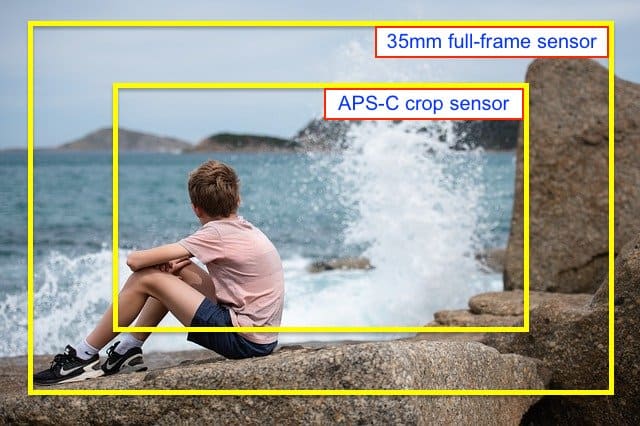
Why does it matter for photographers?
Crop factor is crucial for understanding the field of view and perspective when using lenses on cameras with different sensor sizes.
Photographers need to consider crop factor when choosing lenses to achieve the desired composition, especially if transitioning between cameras with varying sensor sizes.
18. Dynamic Range
Dynamic range is the range of light intensities from the darkest shadows to the brightest highlights that a camera can capture.
It is a measure of a camera sensor’s ability to retain detail in both dark and bright areas of an image.
Why does it matter for photographers?
Understanding dynamic range is essential for photographers who work in challenging lighting conditions.
A camera with good dynamic range can capture more details in high-contrast scenes, preserving information in both shadow and highlight areas.
This knowledge enables photographers to make informed decisions about exposure and post-processing to achieve optimal image quality.
19. Chromatic Aberration
Chromatic aberration is an optical distortion that causes color fringing, typically seen as colored halos or artifacts along high-contrast edges in an image.
It occurs due to the differential refraction of different wavelengths of light.
Why does it matter for photographers?
Chromatic aberration can impact the overall image quality, and photographers need to be aware of its presence and how to correct or minimize it.
Understanding the causes of chromatic aberration helps photographers choose lenses with better optical performance and apply corrective measures during post-processing.
20. Image Stabilization
Image stabilization (IS) is a technology designed to reduce the effects of camera shake during handheld photography.
It can be implemented in camera bodies or within lenses and helps to produce sharper images in low-light conditions or when using longer focal lengths.
Why does it matter for photographers?
Image stabilization is crucial for photographers who shoot in conditions where a steady hand or tripod is not feasible.
It allows for sharper handheld shots in low light or when using telephoto lenses, enhancing the overall versatility and usability of photographic equipment.
21. Hyperfocal Distance
Hyperfocal distance is the closest point of focus that retains acceptable sharpness in an image, while also ensuring that distant objects remain reasonably sharp.
This technique is often used in landscape photography to maximize the depth of field, ensuring that both foreground and background elements are in focus.
Why does it matter for photographers?
Understanding hyperfocal distance is crucial for photographers seeking to capture expansive scenes with clarity from foreground to background.
By calculating and setting the hyperfocal distance, photographers can achieve optimal sharpness throughout the frame, allowing for stunning landscape compositions.
This technique is particularly valuable when a wide depth of field is essential for capturing intricate details in both the near and far elements of the composition.
22. Resolution
In digital photography, resolution refers to the level of detail that can be captured by a camera or displayed on a screen, typically measured in pixels.
For cameras, resolution is often expressed as the total number of pixels in an image (e.g., megapixels), while for displays, it represents the number of pixels per unit of length (e.g., pixels per inch or PPI).
The resolution of an image is determined by the total number of pixels horizontally and vertically. For example, a camera with a resolution of 6000 x 4000 pixels captures 24 megapixels.
Higher resolution images contain more pixels and can represent finer details, leading to sharper and more detailed photographs.
Why does it matter for photographers?
Resolution is a critical factor for photographers as it directly impacts the quality and clarity of their images. A higher resolution allows for larger print sizes without sacrificing sharpness, provides more flexibility in cropping during post-processing, and ensures a better viewing experience on high-resolution displays.
Photographers aiming for professional results or intending to make large prints should consider cameras with higher resolutions to capture the maximum amount of detail in their images.
On top of that, understanding resolution is essential when choosing equipment and post-processing techniques to meet specific quality standards and creative preferences.
23. ND Filter (Neutral Density Filter)
An ND filter is a lens attachment that reduces the amount of light entering the camera without affecting the color, enabling photographers to use longer shutter speeds or wider apertures in bright conditions.
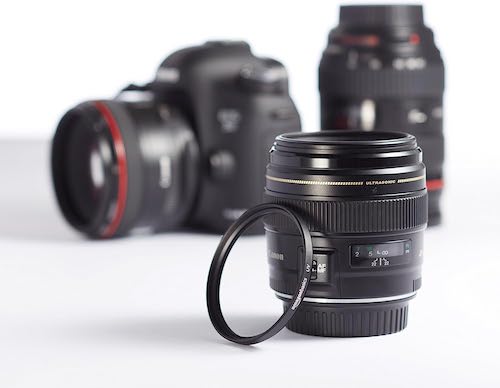
Why does it matter for photographers?
ND filters are essential tools for photographers, especially in situations where controlling exposure becomes challenging.
By reducing the amount of light, ND filters allow for creative effects such as motion blur in water or the use of wide apertures in bright sunlight, enhancing the photographer’s control over the final image.
24. Vignetting
25. Panning
Panning is a photographic technique where the camera is moved horizontally along with a moving subject.
The goal is to keep the subject relatively sharp while blurring the background, conveying a sense of motion.
Achieving successful panning involves tracking the subject smoothly, often requiring a slower shutter speed.
Why does it matter for photographers?
Panning is a creative technique that adds dynamism and a sense of speed to photographs.
It is commonly used in sports photography, wildlife photography, and other scenarios where capturing a subject in motion is desired.
Mastering panning allows photographers to experiment with different shutter speeds and techniques, creating visually compelling images that convey a feeling of energy and movement.
Photography Terms List (Final Thoughts)
There you have it.
While it’s not the most exhaustive list, knowing and understanding these 25 photography words will help you on your journey.
Over time, you’ll keep learning more, but for now I think this list is enough.
(But if you can check out our other post if you want more camera lingo.)
Now, I’d like to hear from YOU:
- Which terminology you were familiar with?
- Any more photography words for beginners to add to this list?
Share your thoughts in the comments below!